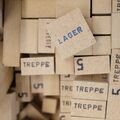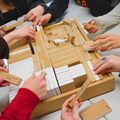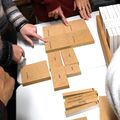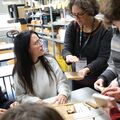Design Your Own Theatre from a Kit
Aims
The activity is a first step towards understanding theatre architecture, and the work of theatre architects. It introduces students to the main parts of a theatre and what they are called. It asks them to think about the possible spatial arrangement of foyers, technical areas, and so on.
Key Information
| Number of learners | Students work in groups of up to four. We suggest that six groups (24 students) is a practical maximum for one teacher in a single session. |
| Number of staff | The teacher |
| ECTS Credits (if applicable) | 0.125 ECTS credits |
Learning process
| Lecture/seminar | Lecture, presentation, discussion (face-to-face or online) | |
| X | Making project | Making a model, mock-up, plan or design (physical or digital) |
| Performance project | Making a performance or demonstration (live or mediated) | |
| Records and Archives | Interviews, photographs and videos of artefacts, annotating archives, creating learning materials (physical or digital) | |
| Independent study | Reading, researching, analysing and evaluating learning materials (physical or digital) in groups or alone |
Type of learner
| X | Student of technical theatre |
| X | Student of theatre design, architecture |
| X | Student of theatre arts |
| Professional | |
| Researcher | |
| X | General public |
What You Will Need
Duration and schedule
The activity takes 2 hours, if model kits are already made:
15 minutes preparation by the teacher, setting out the tables and kits, deciding on the groups
90 minutes with the students:
- 15 minutes introduction
- 60 minutes working in groups
- 15 minutes presentation and discussion
15 minutes tidying afterwards.
Room or type of space
An ordinary classroom, with a table for each group of four students.
Equipment
A kit of parts for each group.
Each kit is a set of wooden blocks, each representing a part of a theatre – stage, auditorium, technical gallery, toilet, restaurant, and so on. These can be put together like a 3D puzzle.
We have provided templates to make the blocks, available as a Canon Tool - see the section on Learning Resources below. You can use all the blocks, for students with some experience of theatre architecture, or if you want a longer time working on the project. Otherwise, choose only the main parts of the theatre.
You can also adapt the kit of blocks to suit a particular type of theatre, or historical period. Our templates are based on a large theatre or opera house, with a ballet company and orchestra.
Students should use their mobile phones to take photos of their work. It is helpful if there is a way to share these photos, such as a projector or screen in the classroom.
Materials (consumables)
None.
Learning resources (books, websites)
You can get the template from the Canon Tools: Template for making the model kit. Use the template to cut out and label the blocks from 20mm thick MDF or plywood.
Architectural plans of theatres. The plans can be presented in the classroom by posters, on screen, as paper copies or in books.
Process
Preparation
Gather learning resources.
The learning activity
Start by introducing the activity, showing the students plans and diagrams of a variety of theatres, explaining and naming the different parts of the buildings.
Then give each student group one hour to use the kit to design their own theatre. At the end of this time, each group presents their ideas to the whole class, and there is a discussion of the results.
Assessment and feedback
Feedback can be immediate, as part of the discussion.
Alternatively, students can be asked to prepare a presentation for a later class.
Our Experience
Tips
The session can be very loud, because students start to discuss very quickly. It is a good idea for the teacher to go around, checking on progress and making sure the students try out different ideas.
Announce the end of the session well in advance, so students have time to be ready to present their ideas.
This is an easy, quick and fun activity!
Additional information and resources
The photos show kit of blocks used at the Beuth Hochschule für Technik Berlin, and students using them to design theatres:
The blocks:
In use:
Credits
| This learning method was made by: | Prof. Dr.-Ing. Bri Newesely, With Dipl.Ing. Sarah Kamender and Dipl.-Ing. Sophia Soehner |
| Institution: | Berliner Hochschule für Technik (BHT) |
| Thanks to: | This activity is based on a 1960 sheet, found in the Theaterbausammlung der TU Berlin, developed during the diploma in Theater- und Veranstaltungstechnik by Dipl.-Ing. Lotte Grenz.
Thanks to students of BHT and the Canon project for demonstrating the kit seen in the photographs. |







